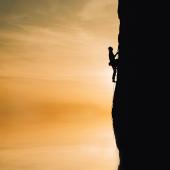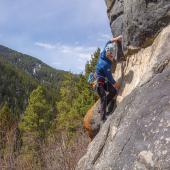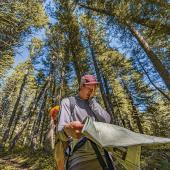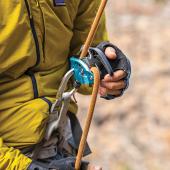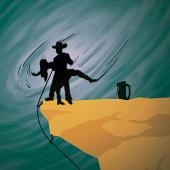Gallatin Tower
Tackling a Bozeman classic.
The rock looked flat to me; nothing to grab but tiny protruding nubs. How the hell do people do this? I thought. Our instructor Coop, scampering up the wall easily a few minutes before, had made it look so simple.
Just reaching for my first hold was a struggle. Slowly I worked my way up the rock, reaching for any pinch I could cling to as I followed the thin crack along my left. Below, the Gallatin River drowned out Hwy. 191’s traffic with the sound of whitewater rushing through the Mad Mile. My only option was to go up. Regardless of the struggle, I didn’t drag myself out of bed at 7 am on a Saturday and drive halfway to Big Sky just to give up on the final pitch. I lunged for my next hold and felt the rock scrape along my skin. A few holds later, I reached over the ledge, looking at Coop’s feet, as I grasped for my final hold.
For me, climbing has always been on the backburner. During the summer, when I don’t feel like hiking 2,000 feet for 20 turns, then I climb—but half-heartedly at best. This summer I wanted to give climbing the chance it deserves. I wanted to gain confidence using ropes on the rock and return to school in the fall ready to leave the bouldering gym behind.
I signed up for a class with Montana Alpine Guides and they showed me the ropes. It was four to a class with one experienced guide, Mike “Coop” Cooperstein, who carries 17 years of experience to share with us. My friend Torry and I showed up at the approach around 8 a.m. with a pair of shoes and an appetite to climb. A few minutes later we had all the gear we needed and were standing at the base of Gallatin Tower. It loomed above us, coming straight out of the canyon—granite still cool to the touch.
Although it was my first true ascent, I still felt confident. Bouldering taught me how to move along the rock, and now I had to use those skills to move me up the rock. After a lesson in knots, I was tied on and ready to follow Coop up the first pitch. We went at a “learning pace.” The first pitch was a warm-up—short but sweet. After securing ourselves on the landing, Coop led the second pitch. The workout finally began with a more technical climb.
Sturdy granite holds led me to the next landing. I was two-thirds of the way up the tower when our goal came in clear sight as the sun moved along the canyon.
The cool morning was left behind and I stared up at our third and final pitch. It was clearly the most technical climb of the day. The rock seemed even flatter up close. The first two ascents were manageable, but the third was going to be a stretch. So I did the only thing I could and reached for my first hold. Next came the right leg. Hold by hold, I left my doubts behind.
From the top of the Gallatin Tower, I had a bird’s-eye view of the canyon. Rafts navigated their way past House Rock and into the Mad Mile. The wind cooled the sweat on my body as I caught my breath, staring up at the spotless blue summer Montana sky.
The class made its way up the last pitch. “You made that look so damn easy,” said Torry as he grasped for his final hold, staring at Coop as he caught his breath.
“Well, that’s my job,” replied Coop.
A quick rappel lesson later and we were on the ground. Hiking to the car, all I could think about was being on the top once more. Half my problem was solved; I had gained knowledge of climbing with ropes. Now I just need to find some gear and keep climbing.
For more info, visit montanaalpineguides.com or call 586-8430.
SPRING CLIMBS
by Drew Pogge
When climbing racks replace skis and boards in the corner of the living room, the burning question becomes “Where?” Where to find low elevation, sunny aspect, and protection from chilly breezes? Southwest Montana is full of crags that can be fun in the early season, and the local climbing shops have tons of information and guidebooks about them. So the following three areas are just a start. Get out, polish up, and have fun.
Allenspur Crag
Just south of Livingston, Allenspur crag is a logical choice for spring climbing. Low elevation and a sun-catching southwesterly aspect can make it a warm place to get honed for the season, but watch out for the famous winds of Paradise Valley--they can cool things down in a hurry. There are multitudes of sport and trad routes, ranging from 5.6 first-timer climbs, to “Spiderman-ain’t-got-nuthin’-on-me” pitches strictly for mutants. The trail to the crags is an easement crossing private property, so respect all markings to help keep Allenspur accessible in the future.
Neat Rock
Neat Rock, along the Madison River just below Red Mountain Campground, has a limited number of routes, but relatively light traffic and intense afternoon sun make it a viable spring option. Mostly trad climbs with some bolts scattered about, Neat Rock has everything from 5.5 cakewalks to 5.11 overhangs for those so inclined. Warm sun, good rock, and Madison River views make Neat Rock pretty… neat.
Scorched Earth
Aptly named, Scorched Earth is another early-season hot spot where climbers can pull down on a variety of challenging sport and trad routes. Difficult bolted routes predominate, and routes no easier than 5.9 will punish winter-softened fingers. Located across Squaw Creek Bridge in Gallatin Canyon, this limestone wall is easy to access and receives abundant sun. The views of the Gallatin River and adjacent canyon walls alone make it worth climbing here.







